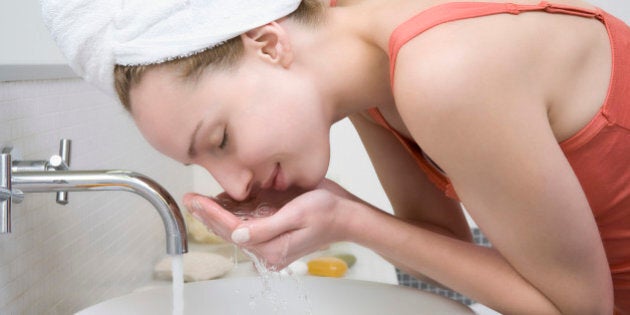
If you're a green beauty junkie like me, you know that in the last few years the natural and organic skincare sector has blossomed into a multi-billion dollar industry. This makes me so happy, when I began reporting on toxins in personal care products (almost 10 years ago now) there was not much on the market to choose from and making the switch from conventional beauty products to more natural ones was difficult.
Today, it's a very different story. The Indie/Eco beauty companies are focusing on consumer health and eco-consciousness, innovation, inspiration and efficacy. They are also taking a big bite out of the personal care market.
And, the big boys, think L'Oréal, Estée Lauder etc. are taking note. What was once thought of a fad, is now a bonafide, legit business.
In fact, so legit, that it's now become harder and harder to know which eco skincare product is right for you and whether the "natural" and "organic" claims are true. So I am going to break it down for you.
The first and most important thing is to understand what the following terms actually mean.
Organic:
There is good news and bad news here. In the United States the word "organic" is highly regulated and legally cannot be used unless a product or agricultural ingredient has been certified by the USDA. If you are buying U.S. brands you must also look for a logo that confirms this. Sound goods right?
Well it's a bit more complicated; the USDA has no authority over the production and labelling of cosmetics, that falls to the FDA (Food and Drug Administration). According to the FDA, you cannot put "false" or "misleading" information on cosmetics labels. Problem is, manufactures only have to voluntarily register their ingredients and labels. And here is where the problem with regulation lies. It's evident we need laws that define labelling, organic claims and personal care certification more clearly.
In Canada the situation is just as bad. The new Canadian Organic Standard does not cover cosmetics. That falls under Health Canada's jurisdiction and currently there are NO rules or guidelines in place for using the words natural or organic. Health Canada really needs to step up their game here, a company can have ONE organic ingredient in it and call itself organic, this is simply unacceptable.
If you are shopping for truly "organic" skincare or cosmetics, you need to look for the EcoCert logo. ECOCERT is an organic certification organization, founded in France in 1991. It is based in Europe but conducts inspections in over 80 countries, making it one of the largest organic certification organizations in the world.
Let's take a closer look at key words.
Natural:
Ooh this term really pisses me off. Legally this word means absolutely NOTHING! It's 100 per cent unregulated and used purely as a marketing tool, or greenwashing. Companies use this term very loosely, if a product contains a trace amount of naturals but is mainly made up of synthetic chemicals, they can claim its "natural". This is where reading and understanding the ingredients is key; I will address this in more detail later on. A good rule of thumb though is if the "natural" ingredient/s are buried at the bottom of the list, you can be sure the product is far from natural.
Non-Toxic:
This one is interesting; in most cases, it's simply a marketing tool. Most of the time it's used when referring to specific ingredients that are toxic to humans when exposed, like phthalates. These nasty neuro and hormone disruptors have been linked to cancer and are normally found in shampoo, conditioner and other household items. Phthalates are a group of chemicals used to make plastics more flexible and harder to break. They are often called plasticizers (YIKES) they are used in cosmetics to make the product more slide.
Hypoallergenic:
This term holds no meaning at all. NADA. It's used to give the impression that the product causes fewer reactions than its competitor.
Next step, is understanding the ingredients. Almost all skincare products are made up of a combination of the following:
Petroleum derived or synthetic ingredients made from crude oil, yep you read that right! And are found in many of your favourite products. This is what you will see on the label:
•Mineral Oil
•Paragen PPG: found in self-tanning products
•Carbomer: found in most body lotions
•Isopropyl: found in everything from shampoo to nail polish
Plant derived botanical ingredients extracted from flowers, seeds and trees, like jojoba oil, coconut oil, essential oils etc. You can identify these on labels by looking for the following key words:
•Phyto: phytosomes
•Coc: cocomide, cocoa butter
•Sorb: sorbic acid, sorbitol
•Palm: palm oil
•Laur: laurel, laureth
Minerals that come from deep within the earth and include zinc oxide, clays, mica, salts and iron oxide. Minerals are listed on labels like this:
•Magnesium
•Aluminum
•Sodium
Animal derived ingredients like beeswax, keratin, collagen and biotin. There is some cross over here, so make sure to look at the label to see if the ingredients are plant or animal derived. Good companies who are transparent will put this information directly on the label. A good example of this is Caprylic Acid - a liquid fatty acid from cow's or goat's milk. Also from palm, coconut, and other plant oils.
You can identity animal ingredients by looking for the following on labels:
•Cetyl: cetyl-alcohol, cetyl stearate
•Glu: glucuronic acid, glutamine
•Gly ie: glycerin, glycogen
•PEG: ie: abbreviated form for polyethylene glycol
•PPG: abbreviated form for polypropylene glycol and polyoxypropylene glycol
Bottom line, is get to know the companies (and ingredients) you are buying from, look for transparency and when in doubt, contact the company directly before make a purchase.
Follow HuffPost Canada Blogs on Facebook
ALSO ON HUFFPOST: